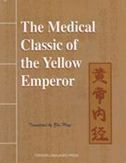The Medical Classic of the Yellow Emperor
Publisher:
Foreign Languages Press
Publication:
1/2001
Languages:
English
Binding:
Hardcover
ISBN/SKU:
9787119026640
Pages:
302
Sizes:
262 x 194mm
Weight:
0.7800
On OrderTo be dispatched within 4 weeks
Special Price
£33.00
£33.00
Regular Price
£34.95
(€36.96)
The Medical Classic of the Yellow Emperor (Huang Di Nei Jing) is the oldest extant classic of traditional Chinese medicine. Compiled about two thousand years ago, this masterpiece forms the theoretical basis of TCM. As traditional Chinese medicine developed over the millennia, nearly all significant medical works benefited from this unparalleled book. Covering not only medicine but also philosophy, sociology, anthropology, military strategy, mathematics, astronomy, meteorology, ecology, The Medical Classic of the Yellow Emperor demonstrates that even in ancient times, people accomplished scientific achievements that are applicable, relevant, and innovative even in modern times. 'The author chose the authoritative and consummate . . . version of The Medical Classic of the Yellow Emperor . . . as the source work for his translation into English. The book is structured to present the translations of an original article or section of dialogue, followed by annotations and commentaries. For example, the original article says ?Open the ghost gate and cleanse the clear fu-organ?, while the annotation which follow says, ?Diaphoesis and diuresis.? The reason for the significant difference is that the latter presents a readily recognisable gloss in Western medical terminology, while the former presents a literal translation of the original text that is closer to the expression accepted by practitioners of TCM in China, and comes closer to reflecting the real meaning in the context of TCM conceptualisation. 'The style of translation is literal and verbatim, a choice made by the translator to avoid where possible the pitfalls of narrowly specialised experts who might inadvertently alter the transmission of information. Overall, the text is arranged with an introduction and overview, with eight chapters covering the theory of yin-yang and the five elements, the zang-organs and manifestations, the theory of channels and network-channels, theory of pathogens and pathomechanisms, diseases and symptoms, diagnostic methods, therapeutic principles and methods, and the theory of health preservation.'




